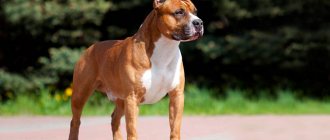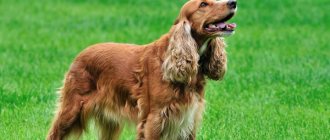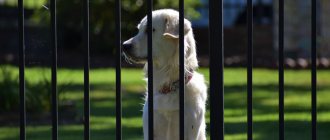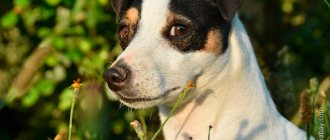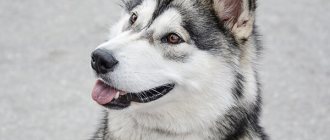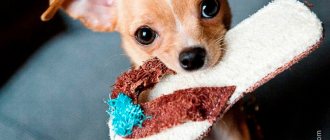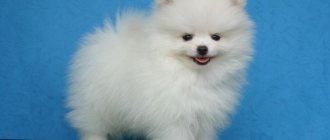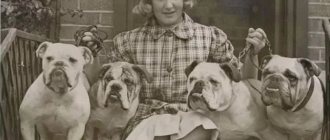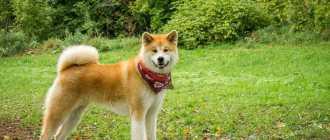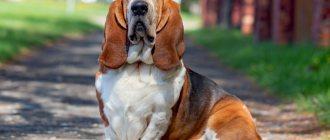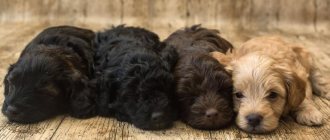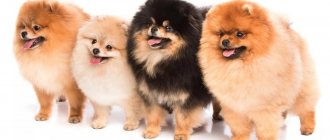History of the origin of the species
The breed originated in Germany, but Great Danes have a long history. They originated from Egypt, Rome or Greece, since the Greek coins date 36 BC. e. depicts a dog similar to a Great Dane. Images of dogs similar to them were discovered on Egyptian monuments dating back to 3000 BC. e. In Tibetan literature for 1121 BC. e. Danish-type dogs are also described.
Medieval greyhounds or mastiff-type dogs were used by the Asians known as Alans who invaded Germany, Italy, Spain in 407 AD. e. They brought dogs with them, which showed great strength in killing bears and wild boars. Therefore, the Germans began to selectively breed Great Danes. The breeds chosen to breed the Dane could include the Irish Wolfhound, Mastiff, Greyhound.
In Germany, the Great Dane became the country's national dog in 1870. In 1880, it was decided that the breed, bred by the Germans, was separate and would therefore be known as the German dog. In the mid-1800s, dog lovers in the United States began importing Great Danes from Germany, and by 1891 the American Club was formed.
Features of Great Danes
This is definitely a pet for whom counter-surfing is a favorite pastime. A strong tail would make a good weed killer and is at just the right height to clear a coffee table. Regarding the relationship between height and length, the Great Dane should be “square” and the body should be as long as its height.
The ears are floppy and triangular, although in the US they are often trimmed. Ear cropping was done to prevent injury when hunting wild boar. There is no real reason to crop a companion dog's ears, and the practice has been stopped in many European countries.
Although Great Danes are huge, they are loving, kind, gentle, even with children. They become attached to their owner and want nothing more than to curl up in their owner's lap, although such a prospect almost always seems impossible.
Blue Great Dane (interesting facts)
Gray dogs develop a blue tint to their fur in certain lighting conditions. This gives a special elegance to the breed. The Blue Great Dane has short hair that is not designed to withstand heat and cold. White spots may be present on the surface of the chest.
The dog is affectionate, cheerful, attentive to its surroundings. Hunter genes make themselves felt. It acts as a good guard for the owner.
Character
Dog is a reliable friend. She is friendly, courageous, energetic. This is an easy-going breed, regardless of its size. The Great Dane is friendly, affectionate, especially with his family, and shows self-confidence in the company of strangers. He is gentle and loves nothing more than playing with children.
Their gigantic size makes them dangerous in the home environment. Children and teenagers will find these giants a dream stuffed animal.
The calm and balanced nature makes the Great Dane an ideal breed for keeping in small spaces, perhaps even in apartments. He won't mind lazing around all day with his beloved owner nearby.
Health
Great Danes are healthy dogs because they were specially bred for work, hunting bears and wild boars. The change in breeding goal caused health problems. They are vulnerable to stomach torsion, which can begin with bloating. This condition is common in large, deep-chested breeds. The reason is eating large amounts of food and drinking too much. This can lead to stomach twisting. The condition requires emergency medical attention, as the blood supply to the stomach and small intestine may be disrupted. This interferes with the normal flow of blood back to the heart and can lower blood pressure and lead to hypovolemic shock.
Apart from stomach torsion, Great Danes are prone to hip dysplasia. This condition causes pain when moving or causes lameness. If not corrected immediately, canine arthritis may develop.
Great Danes are also susceptible to:
- osteosarcoma;
- dilated cardiomyopathy;
- tricuspid valve dysplasia;
- mitral valve defects;
- subaortic stenosis.
There are other diseases that can negatively affect the health of a Great Dane. This emphasizes the fact that puppies should only be taken from reliable breeders who guarantee the absence of genetic abnormalities.
Recommended health tests: hip assessment, cardiac examination, ophthalmological examination, thyroid diagnosis.
Nutrition
The diet, in general, is not much different from that of other large breeds. The main requirement for nutrition is balance. Dry food is well suited for animals; there are special mixtures specifically for Great Danes. It is beneficial for the body to supplement the diet with natural products, but not from the master’s table, but only from the list of permitted ones:
Black Great Dane
- Dairy products.
- Raw chicken, beef, turkey.
- Raw fish – preferably sea fish.
- Eggs – raw, no more than 2 eggs per week.
- Porridge.
There is also a list of products that are contraindicated for Great Danes. They are poorly absorbed by the digestive system and may be one of the reasons for the deterioration of a dog’s health:
- Floury.
- Sweets.
- Smoked meats.
- Bean porridge.
- Spicy food.
Do not forget that a dog is a predator by nature. The abundance of food of plant origin is harmful to her. Although vegetables and fruits are not prohibited for dogs, they are accepted willingly and should not be abused.
Great Dane puppies
The volume of food eaten can be determined based on the weight of the animal. Up to 5% of its own weight is enough per day for an adult. The feeding frequency for dogs of all breeds is the same - twice a day.
Care
Great Danes have relatively short fur—surprisingly smooth for their size. There are 6 colors: fawn, brindle, black, harlequin, blue, mantle. Wool does not require long-term care. A stiff bristle brush helps maintain its integrity. Regular brushing minimizes the frequency of bathing.
Frequent tooth brushing is necessary. Experts recommend carrying out the procedure at least 3 times a week, since dogs of this breed are especially susceptible to the development of tartar and plaque. Brushing your teeth daily should help prevent gum disease and also eliminate bad breath.
You need to trim your nails 1 or even 2 times a month. The dog itself will give a signal - a clicking sound that can be heard when walking on the floor. This is a sign that it's time to cut your nails.
Mating
In addition to the basic rules of mating, common to all large breeds of dogs (first mating after the third heat; upon reaching the age of 22-24 months ; mating of healthy individuals in the territory of a male dog in the morning on an empty stomach), there are special rules in breeding Great Danes.
These rules are established by the National Great Dane Club and relate, first of all, to the prohibition of mating individuals of different colors.
The following combinations of different types of knitting are acceptable:
- black and blue;
- fawn and brindle.
It is not recommended to breed a bitch more than once a year.
Photographer: Monica van der Maden
Content
Great Danes need daily walks to stay healthy. It is important not to overwork this breed, especially when young. Puppies grow large, which puts them at risk for joint and bone problems. Because of the puppy's natural energy, owners should take steps to minimize activity while the pet is growing.
Great Danes continue to grow (mostly by gaining weight) longer than most dogs, only reaching maturity at three years of age. Although they love to run, they are not suitable as a jogging partner until they are one year old.
Adult dogs will enjoy a long daily walk or active play in the yard. Young representatives of the breed have a lot of energy, but as they age they become quiet at home and can even live in an apartment. Even well-trained obedience dogs run without listening to commands and often get hit by a car.
This breed is easy to care for. Trim your nails monthly. Bathing is hard work, so a groomer (a modern brush) can help reduce the number of procedures. The coat should be brushed with a hard bristle brush and then treated with dry shampoo. Daily care is a good idea if you need to avoid washing.
Due to the large size of the Great Dane, it thrives best in spacious homes with room to run and play. This breed is prone to staying indoors, so spending time outside every day is important for their health.
Bordeaux
The Dogue de Bordeaux is a very ancient breed, bred in France. These are large dogs with a squat body and heavy weight - up to 90 kg. The minimum weight prescribed in the standard is 50 kg. The height at the withers of these dogs is 58-68 cm.
The dog's body is covered with wrinkled skin, which forms many folds. Her body type is muscular and athletic. The chest is wide. The head is large with a wide forehead and a short, wrinkled muzzle. The ears are small and drooping. The eyes are oval, brown in color. The nose is wide. The head is located on a short muscular neck. The limbs are shortened, highly developed, vertical.
The coat is short and dense. A single color of various shades of red is allowed. There may be a dark mask on the muzzle. There is a white spot on the paws and chest.
Find out also how to make your own kennel and enclosure for your dog
Like most Great Danes, the Bordeaux representative often does not even need to do anything to protect the house or owner; his intimidating appearance will speak for him. However, as in other cases, a formidable appearance is just a cover behind which hides a kind and cheerful disposition. This four-legged animal is open, sociable, loyal, and balanced.
Only an experienced owner can keep the Dogue de Bordeaux . Apartment conditions are suitable for maintenance, but the owner needs to allocate a lot of time for active walks. This dog is not suitable for cleanliness - it drools profusely.
Important! It is not advisable to keep the Dogue de Bordeaux only in the yard. He does not tolerate lack of communication and loneliness. The best conditions for him are a spacious house.
The life expectancy of representatives of this breed is 10-12 years. When deciding to purchase a puppy, be prepared to shell out $450-$1000 for it.
Upbringing
The Great Dane's desire to please its owner makes it easy to train, train and obedience. Socialization should begin at an early age. You need to start acquiring basic skills as early as possible. Great Danes are not as intelligent as other dog breeds, but their desire to earn their owner's affection underscores their willingness to learn.
Inviting guests into the home can introduce Great Danes to the nature of human interactions. Visiting busy parks also helps introduce them to everyday life.
Breed traits
Breed traits (on a 5-point scale)
| German dog | |||
| Activity | in the house | 2 | |
| on the street | 3.1 | ||
| Obedience | training | 3.6 | |
| strangers | 4.5 | ||
| Domination | in family | 1.8 | |
| over dogs | 2.5 | ||
| Defending your territory | from people | 2.9 | |
| from dogs | 3.4 | ||
| Sociability | in family | 4.9 | |
| with strangers | 3.7 | ||
| with dogs | 3.3 | ||
| Concentration | in family | 1.1 | |
| in front of strangers | 1.9 | ||
| with dogs | 2 | ||
| Aggressiveness | in family | 1.1 | |
| to strangers | 1.8 | ||
| to the dogs | 2 | ||
| to cats | 2.2 | ||
| Family behavior | calmness | 4.4 | |
| demand for affection | 4.7 | ||
| excitability | 3.3 | ||
| playfulness | 3.6 | ||
| excessive barking | 1.7 | ||
| behavioral breakdowns | 1.8 | ||
| Tolerance for children | up to 4 years | 4 | |
| over 4 years old | 4.2 | ||
| Institutional use | watchman | 4.3 | |
| bodyguard | 2.6 | ||
This breed is often compared to the following dog breeds: Doberman (Doberman Pinscher), German Shepherd, Dalmatian, Cane Corso, Longhaired Collie.
The photographs show what Great Danes look like:
Marbled Great Dane
Two Great Danes
Great Dane head
Two marbled Great Danes
Pros and cons of the breed
Great Danes have certain characteristics:
- friendliness with family members, especially children, as well as other animals;
- self-confidence in the presence of strangers (does not show anxiety);
- no difficulties in care;
- easy training;
- devotion to one's family;
- restraint and genuine tenderness.
The Great Dane is not suitable if you:
- live in a small apartment;
- do not realize the importance of early training and socialization of puppies;
- you cannot spend a lot of time, especially for physical exercise or games;
- going to leave it for long hours every day;
- Can't stand pets that drool a lot.
Breeding
A sexually mature female is a dog that has entered its first heat. Most often it occurs at 8-9 months, and the frequency is at least six months. A female can only be bred after reaching 22 months of age. Mating is best carried out under the supervision of a veterinarian or a specially trained instructor.
Very often, upon completion of the process, mating occurs in animals. It can last up to 60 minutes. During this period of time, it is forbidden to separate the female from the male by force; it is recommended to wait for natural separation.
How to choose a puppy
Ask to see your parents. The purebred Great Dane has a smooth, muscular body and its movements are balanced. There is no visible deformation on the bodies of the parent dogs.
Review the health examination results of the parent dogs if the breeder shows them to you. Pay attention to problems: bloating, thyroid disorders, bone problems. Puppies are required to be vaccinated before 6 weeks of age, and it is best if they have been vaccinated by a veterinarian.
Observe the behavior. Puppies interact normally with each other. Healthy offspring are alert and playful. Great Dane puppies that have undergone proper socialization show curiosity and do not shy away from human contact.
Possible diseases and methods of treating them
Unfortunately, active and energetic large dogs often face the problem of damaged legs. While running, they may fall, dislocating or breaking a leg. If you see your pet fall unsuccessfully, we advise you to leave him in a lying position and call a veterinarian at home.
Well, if this is not possible, you will have to put a splint on the dog and transport it to the clinic yourself. If your Great Dane constantly whines and doesn't move much, he may have joint dysplasia. In this case, he will need professional help.
As additional care for your dog, give it anti-parasite medication every summer, and feed it with fresh fruits and vegetables in winter. You can also pamper your four-legged pet with non-acidic berries, such as watermelon (in season, of course).
The Great Dane is a wonderful dog. He is kind, loyal and playful. It is pleasant to interact with him, both for children and adults. Remember to systematically care for your animal to ensure its lifespan is as long as possible.
Popular types of Great Dane dogs
Many varieties have been developed. Each species has certain appearance and character traits. Before adopting a puppy, study the characteristics of the species so as not to encounter difficulties when choosing.
American
The most fearless variety of the breed, known since the end of the 19th century. Height is up to 68 cm at the withers, and body weight is about 55 kg. Sexual dimorphism is pronounced. They have long, hanging V-shaped ears and a muscular and strong build. Their coat comes in different shades such as white and grey, black, dark brown, brown.
The massive physique is deceptive - in fact, these are cute, affectionate pets. But they do require early training and socialization by an experienced owner. This is not a lap dog, but a symbol of the US Marine Corps. There are classic varieties (with a short muzzle) and standard (elongated muzzle, light build).
Argentinian
Displayed for search and service purposes. He has a complex character and is prone to aggression. He is stubborn. Needs early socialization. An elegant, muscular mastiff breed. They have a wide, deep chest, giving the overall appearance of power and confidence. They have loose skin on the neck.
Characterized by temperament and perseverance. Always wins thanks to his extraordinary strength. They are sociable and cheerful in families - they become a real support.
English
“Royal” breed, characterized by arrogant behavior. A measured dog that knows how to control its own behavior. The fur has a beige tint, there is a black mask on the muzzle, and the ears also have a dark tint.
There are folds on the face of the English Great Dane, giving it a thoughtful appearance. The dog looks like the picture.
Canary
A mix of Great Dane with Bulldog and Mahorro. Their coat color comes in different shades such as brown and white, black and white and grey. The breed was bred to work with cattle. Height does not exceed 66 cm.
This is the type of dog that will happily go fishing, hiking, or boating with you. But they usually have breathing problems, just like a purebred American Bulldog, so you shouldn't overdo it. Thus, great caution is required when going out in the sun with your dog.
Brazilian
The Filo Brasiliero breed was developed by crossing a bulldog and a mastiff. It is massive. According to the standards, all colors are allowed. The Brazilian dog has a body type that gives the impression of agility and strength. Their bodies are muscular, long and defined, and their bones are strong. They have a strong, arched neck of medium length, and muscular shoulders.
The behavior shows the traits of a hunter and a tracker. They have the character traits of the “British” - equanimity, patience and measuredness. In some countries the breed is not allowed for breeding.
German
He has an aristocratic appearance and a calm disposition. The breed was bred for hunting. It is a very calm companion accompanying a person’s life. The body is shaped closer to a square. The physique is muscular, emphasized by smooth hair.
Tibetan
Most often called a mastiff. It has a thick coat and dense undercoat. Thanks to this, it tolerates low temperatures quite well. Adult cables have a body weight of 60-70 kg. Height – at least 70 cm.
The appearance is mesmerizing. Character - brave. The dog is ready to fight with the offender. Strict training is recommended, as the Tibetan Dogo is prone to making independent decisions.
Cuban
An extinct species bred on Liberty Island (the unofficial name of Cuba). It was bred by crossing a bulldog and a mastiff. The breed was intended to search for Indians escaping slavery. There are practically no representatives left.
Alanian
SONY DSC
The breed is not recognized internationally. They were bred for hunting in pens and for baiting wild animals. The Alanian Great Dane began to disappear due to the reduction of land. It also has a special brindle coloration.
Moscow
An almost extinct breed from the Krasnaya Zvezda kennel. A Great Dane was crossed with a Shepherd. Differs in endurance and power. The forehead is sloping, the head is wedge-shaped. Characterized by special attentiveness and obedience.
French/Bordeaux
A characteristic feature of the breed is its massiveness. The skin is thick and forms folds. Has short silky fur. The standard color is red, there is no mask on the face. Has a menacing appearance.
Russian
The breed was developed using terriers, shepherds, molossians, schnauzers and mountain dogs. The breeders were faced with the task of obtaining a working dog that would perform security and watchdog functions with moderate aggression. With good upbringing, it gets along with its owners in cramped conditions.
Dwarf
A cross between a bulldog and a bull terrier, bred in America. The size of the dog is small: at the withers – 15 cm. Weight – no more than 10 kg. Thanks to its miniature size, the dog can be kept indoors. The genetics of the Miniature Great Dane make him active, curious and cheerful. Easy to train. Suitable for living in city apartments.
Neapolitan
An Italian representative of the Great Dane, the body is covered with numerous folds of skin. These are the protectors of dogs in gladiator fights. They have an elongated body and a squat appearance. Coat color is dark silver. The appearance is frightening, but the character is good-natured. In case of danger, it emits a warning bark.
Chinese
A rare medium-sized variety - a rarity for European countries. The name of the breed is Chongqing. Characterized by restless behavior, aggressiveness and courage. The fur is bright brown. Puppies need early socialization and strict housing conditions. During the training process, the puppy chooses one owner and obeys only him.
Belgian
An endangered breed bred for draft power. It was used to transport wounded soldiers, help with housework and protect the territory. The coat color is black or red. Requires physical exertion and constant activity.
Japanese
A representative of a giant breed with the characteristic appearance of a mastiff. Body weight is 40-90 kg. Adult representatives attack only on command and are distinguished by fearlessness. Characterized by power. Education requires a special and attentive attitude. It is recommended to involve professionals.
Pakistani
The breed was developed based on the Dogo Argentino. Has a strong natural grip and is courageous in all situations. Color – white with dark splashes. The pet's body weight reaches 100 kg. The breed is dangerous - there are no barriers for it. The Pakistani Great Dane can attack without warning, so it needs a strict owner and proper training.
Staffordshire
A fighting breed obtained by crossing terriers and bulldogs. It has a tough and complex character. There are notes of aggression. Difficult to educate. With a medium body size, it has excellent muscularity. Fearlessness causes the dog to fall down without warning. Has a stranglehold and does not tolerate competition. It's difficult to get along with children. Does not tolerate other pets.
Bernese
The predecessor is the Tibetan Great Dane with thick long hair. Color – tricolor (brown, black and white). The Bernese Dog is the most good-natured representative who faithfully serves, protects and cares. Loves pets and children. They are distinguished by their muscularity. Doesn't show aggression. Has a square head and muzzle.
Thai Dane
The breed was bred in Thailand. A Great Dane was crossed with a jackal, resulting in an interesting breed that deserves the attention of dog lovers. The Spitz-like species is easy to jump and train. It is distinguished by its protective character and playfulness.
When raising, you need to focus on security capabilities, carelessness and irrepressibility. You can keep it in urban apartments, despite the pet’s excessive physical activity. If you engage in active games during walks, the dog will not bother you at home.
Canary
We continue our review of Dogo dogs with a description of the Canarian representative. It is easily recognized by its characteristic brindle and fawn colors and black mask on its face. It was bred on the islands of Tenefe and Gran Canaria. Used for shepherding purposes.
Males reach a height at the withers of 60-66 cm, females - 56-62 cm. Their weight is from 40 to 65 kg. These massive dogs are longer than they are tall. They have a large, massive, square head. Muzzle with a wide nose and almond-shaped eyes. The ears are medium, widely spaced. When wrapped, they resemble a rose petal. The neck is straight, long, and muscular. Limbs are straight and proportional. The paws are round, similar to a cat's.
The coat is short, smooth, without undercoat.
Like most Great Danes, the Canary has a good-natured and affectionate character. He may be wary of strangers, but will never show aggression unnecessarily. The dog has a stable nervous system and high intelligence, so it does not act unbalanced. They bark only in very exceptional cases.
“Canarians” are usually kept in apartments or private houses.
Important! An indispensable condition for raising a Dogo Canario is to suppress its dominance. Its owner must be persistent and domineering. Otherwise, problems with the pet’s character cannot be avoided.
The average life expectancy of Dogo Canarios is 9-11 years. A dog can be purchased for $1,200-$3,000.
Adviсe
Regardless of which Great Dane mix breed you choose, socialization and obedience training should be included. Agility training should be introduced as the puppy gets older to stimulate the mind and body. They love to be challenged, so it's safe to say they'll love the opportunity to engage with a puzzle toy while spending time at home.
Simple rules will help with raising a good, reliable assistant and a true, loyal friend:
- Is a Great Dane suitable as a watchdog? No. Despite its large size, this breed is gentle and friendly. They love other animals, children, and even the guy who is about to rob you. They rarely bark, so they do not cope with security functions.
- Do you need to train your Great Dane a lot? These dogs will enjoy a daily walk or romp in a fenced yard, but too much exercise, especially as the dog grows, can put him at risk for bone and joint problems. Tires faster than some smaller breeds.
- Is the Great Dane a good family companion? Definitely. These dogs are easy to train and can adapt to any size living space. Most people assume that large dogs need large homes, but in the case of the Great Dane, he will also be happy to lounge around once he gets older.
- Does the dog need socialization? Early and always. Due to their enormous size, these dogs can pose a threat if they are not used to being around people. They need to be taught not to jump up as they are larger than most people. Although they are easy to train and generally laid-back, exposing your dog to a wide variety of people, places and situations should begin at a young age.
You need to be prepared for huge feed bills. Leftover food from the communal table will not work. Great Danes are given high quality food, especially during their growth period. Dogs have many genetic health problems that they are susceptible to. This must be taken into account when choosing a puppy, paying attention to genetics. Crates, collars, toys, shampoos and all other accessories must be purchased in XXL sizes.
Brazilian
The Dogo Brasileiro is better known as the Fila Brasileiro. This is a large representative of the Molosser, reaching 60-75 cm at the withers, and in weight - from 40 to 90 kg. The exact origin of dogs is unknown, but there is information that they were used as hunters, shepherds, watchmen, and chasers of slaves. Today, with proper training and timely socialization, Fila Brasileiros grow into excellent companion dogs and family pets.
In appearance, “Brazilians” are somewhat reminiscent of Dogo Argentinos. They are strong, muscular, massive. Their head is large, but its size is proportional to the body. The muzzle is long. The ears are not set high, long and drooping. The eyes are in the shape of tonsils or triangles. Limbs parallel, straight.
The coat comes in short and medium length. It is dense, hard and shiny. The most common colors are black, white, and brown. Various variations are possible.
By temperament, these dogs are friendly, loyal, courageous, decisive, vigilant, and balanced. They are wary of strangers, tolerant of children.
The average life expectancy is 12-13 years. Prices for puppies start at $400.
